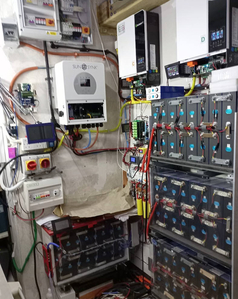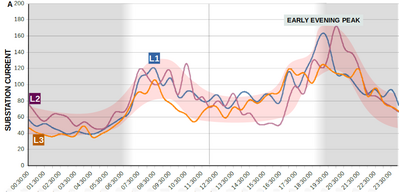Heat Batteries
Hi
We heat our 1980 chalet bungalow in Shropshire with a tepeo ZEB heat battery and a mix of UFH and radiators.
The ZEB is a dry-core heat battery, that consumes electricity when it is cheap, and stores it as heat. That heat is then delivered to the hydronic heating system when called for by a thermostat, in our case a Honeywell Evohome that modulates the ZEB using OpenTherm. As we have a time-of-use electricity tariff that means that the heat we use at 6pm in the evening cost 7p/kWh from the off-peak period, rather than 27.8p/kWh from the peak period, equivalent running costs to a CoP of ~3.9.
We also have a Sunamp Thermino, controlled by a Myenergi Eddi solar diverter, for hot water as we don't have a lot of space for a traditional cylinder.
For full disclosure I work at tepeo. But I like to think I can be objective, and I'm happy to talk frankly about my lived experience with our ZEB and Thermino.
Copied across from the Hello and Welcome Topic:
Posted by: @transparentMy comment about your 3ph requirement was related to you having two EVs.
Posted by: @wullyI think we're a fairly typical 2 car (1 big & 1 small) family, and both cars only need charging once per week each, which means we rarely have both plugged in, and we can cope if a full charge is spread over several days. In the middle of winter we can pull 18kW overnight, with ZEB (9kW), Thermino (3kW) and Libbi (5kW) charging at the same time. Generally though the off-peak window is large enough that none of these devices are charging throughout, so we generally see 12kW maximum.
So the MyEnergi Libbi is your storage battery?
What's its capacity in kWh?
And where is its electricity being used do you think?
Save energy... recycle electrons!
Posted by: @transparentSo the MyEnergi Libbi is your storage battery?
What's its capacity in kWh?And where is its electricity being used do you think?
It's currently a 5kW/15kWh Libbi, as we're homeworkers in a pure electric, tech-heavy household.
Is 15kWh to be regarded as particularly large @wully ?
How much storage would you need to keep working in Britain suffered a similar outage to the one in Spain & Portugal on 28th April?
And on a related issue, would any of your equipment be able to function if the grid was down?
Or does it all rely on synchronisation to 50Hz grid frequency?
A ZEB which could still operate during a power-cut should be achievable if it only requires 25w to keep running .
You gave that figure over on the Hello Topic, but I don't know if it includes the circulatory pump.
Here's a current 'ongoing project' as you call it!
I went down the storage battery route over 5 years ago.
However, the strategy was born out of a calculation (on another forum)
where I compared the amount of energy which could be stored in 3D-space to keep the home heated for around 3-hours.
The two contenders were a water-cylinder supplied from a heat-pump and an electric battery.
A lithium-based battery occupied around 20% of the space for the same kWh
Technology has moved on since then, and heat batteries probably offer a more favourable comparison.
We'd be interested to hear your views.
Save energy... recycle electrons!
Posted by: @transparentAnd on a related issue, would any of your equipment be able to function if the grid was down?
Or does it all rely on synchronisation to 50Hz grid frequency?
A ZEB which could still operate during a power-cut should be achievable if it only requires 25w to keep running .
You gave that figure over on the Hello Topic, but I don't know if it includes the circulatory pump.
Internally a ZEB has some components in common with a combustion boiler. It has an air-water heat exchanger, and it has a fan (but in this case the fan isn't used to provide air for combustion, but to extract heat from the thermal store). So in a power cut the ZEB will not operate, unless there's also battery storage in the house. If that's the case then the power consumption of the ZEB when delivering heat (discharging) is 25W on average, to run the internal air fan. The power consumption of the circulation pump(s) and heating controls is on top of this.
Posted by: @transparentThe two contenders were a water-cylinder supplied from a heat-pump and an electric battery.
A lithium-based battery occupied around 20% of the space for the same kWh
Technology has moved on since then, and heat batteries probably offer a more favourable comparison.
The mass and volumetric energy densities of a dry-core heat battery are pretty good, certainly way better than a water cylinder. Comparing a ZEB installation with an installation of three Tesla Powerwall 3 and a flow boiler, both have approximately the same energy storage capacity, physical footprint and weight. The Powerwall installation is more flexible, as you can use the stored energy for heat and for powering appliances. But that flexibility comes at considerable cost, which is always a consideration.
Posted by: @transparentA lithium-based battery occupied around 20% of the space for the same kWh
Technology has moved on since then, and heat batteries probably offer a more favourable comparison.
We'd be interested to hear your views.
It seems to me that the key metrics on which to compare energy storage technology are
- £/kWh
- m^3 per kWh and to a much lesser extent kg/kWh
- and flexibility
Sadly oil maxes out (in a 'good' way) on all of these, but making it at home is tricky. Electricity (ie batteries) score highly on flexibility but not sure about the other metrics.
Would really like to see a comparison! Im hoping someone will produce one so I don't have to do the research and math myself.
4kW peak of solar PV since 2011; EV and a 1930s house which has been partially renovated to improve its efficiency. 7kW Vaillant heat pump.
@jamespa Anyone care to make a prediction as to how long before decreasing solar panel and storage medium acquisition costs show oil to be the more expensive option? It might be a while longer than that before the battery kg/kWh properties compete with oil though! Regards, Toodles.
Toodles, heats his home with cold draughts and cooks food with magnets.
Posted by: @jamespaPosted by: @transparentA lithium-based battery occupied around 20% of the space for the same kWh
Technology has moved on since then, and heat batteries probably offer a more favourable comparison.
We'd be interested to hear your views.
It seems to me that the key metrics on which to compare energy storage technology are
- £/kWh
- m^3 per kWh and to a much lesser extent kg/kWh
- and flexibility
Sadly oil maxes out (in a 'good' way) on all of these, but making it at home is tricky. Electricity (ie batteries) score highly on flexibility but not sure about the other metrics.
Would really like to see a comparison! Im hoping someone will produce one so I don't have to do the research and math myself.
Not sure I'd say oil maxes out in terms of flexibility, @jamespa; at least in my house (before ASHP), it was the least flexible option since it couldn't power home appliances and, unless I got an AGA, I couldn't cook with it.
That said, I do also, for comparison purposes, maintain a history of the oil prices at the times of year I used to fill up the tank. Currently, it gives a cost (inc VAT) of 5.19p/kWh which is certainly better than gas and substantially better than any leccy tariffs can sustainably manage. That equates to a delivered energy price of (assuming 90% efficient boiler) 5.77p/kWh. At the peak (back in May 2022), when the price per litre went over £1, the cost was 9.23p/kWh which still isn't shabby even though (same boiler assumptions) the delivered energy was 10.26p/kWh
The cubic metres per kWh is something I'm less comfortable with. In order to run a house on oil, I had to maintain a tank that was about 3 cubic metres. Now I'm on solar, my battery is about 2% of that but only holds 6kWh. If I were to add multiple batteries to allow me to get through a whole day I'd still be at only a small fraction of the size of the oil tank. The issue here is that the oil tank has to be big enough to at least receive the minimum oil delivery (usually 500 litres) whereas a home battery can receive multiple smaller "deliveries" per day. It's not space per kWh so much as space needed for all the kWh you need to consume before the next "delivery" and here I'd say leccy wins hands down.
105 m2 bungalow in South East England
Mitsubishi Ecodan 8.5 kW air source heat pump
18 x 360W solar panels
1 x 6 kW GroWatt battery and SPH5000 inverter
1 x Myenergi Zappi
1 x VW ID3
Raised beds for home-grown veg and chickens for eggs
"Semper in excretia; sumus solum profundum variat"
@majordennisbloodnok And of course, ‘No deliveries between 16:00 and 19:00’ as the fuel is in great demand elsewhere😉. Toodles.
Toodles, heats his home with cold draughts and cooks food with magnets.
May I present the maths I referred to earlier when discussing the comparison between storing energy as hot water v other alternatives, such as a battery.
@toodles suggests avoiding 16:00-19:00 for main electricity, which reflects the early-evening demand peak.
In practice the peak is longer than that for the majority of the population living in urban areas.
Let's imagine that we have a heat pump which isn't going to draw from the grid for 4-hours out of the 24.
And we'll make the maths easy by assuming that the house has a daily heat loss of 100kWh.
We'd need a water cylinder capable of storing 4/24 x 100kWh which comes to 16.7kWh
Now suppose your heat-pump is such that it can deliver water at 50°C max, and that you're prepared to allow your radiator temperature to fall to 35°C by the end of the 4-hour period. Your Thermal store will exhibit a 15°C drop whilst delivering that 16.7kWh.
The calculation:
1 watt of power for 1 sec = 1 Joule
Thus 1kWh = 1000 watts x 60 secs x 60 mins
and therefore
1kWh = 3,600,000J (3,600 kJ)
16.7kWh = 60,120,000J (60,120kJ)
We need to find the mass of water which will hold that energy.
Energy required = Specific Heat Capacity x Temp loss x mass in grams
where the Specific Heat Capacity of water is 4.184J/gram/°C
Change the formula around:
Mass (grams) = Energy / (Spec Heat x Temp loss)
= 60,120,000 / (4.184 x 15°C)
= 957935 grams
Convert to kilograms = 957.935Kg
1Kg of water is 1 litre capacity, so we need a tank holding almost 1000 litres
1 litre of water occupies a cube with each side being 100mm.
Conclusion:
Assume that this tank is a cylinder with an internal diameter of 800mm (about the largest domestic hot water cylinder you could buy!)
Volume of a cylinder : V=πr²h
Change around the formula to find height (h)
h = V/(πr²)
Our cylinder would then need to be 1.98m tall.
Add at least 40mm of high quality insulation around it, plus the stainless steel strong enough to contain 1 metric-tonne of water.
That gives you a tank almost a meter across and the height of the ceiling in an average home. ![]()
Feel free to play around with my figures.
I just wanted to make sure that the required formulas were presented in this Topic.
Why is this relevant now?
Because the Department of Energy and Net Zero (DESNZ) has just concluded the 3rd public consultation on a Smart & Secure Electricity System.
Their firm proposal is to implement a process to be called Consumer Led Flexibility (CLF).
That will allow 3rd parties to act as Load Controllers.
Households who sign up to do so will have their heat-pumps turned off during the early-evening demand peak as required by national statistics.
The Load Control Agent will then credit the householder's Energy Account for providing that demand-reduction.
It's therefore worthwhile considering how a house might remain heated during that period by storing energy in advance.
I have responded (twice) to the latest round of SSES Consultations.
The proposals are sufficiently complex that I doubt there are many consumers who could do so...
... which suggests it's being imposed, rather than genuinely being Consumer-led.
@wully will be pleased to note that I've mentioned the Tepeo ZEB despite there being no obvious question about such technologies within the Consultation!
I thought it was important to draw the attention of the SSES Team to domestic heating strategies which exist at the fringe of those they hope to control.
Save energy... recycle electrons!
Posted by: @transparentBecause the Department of Energy and Net Zero (DESNZ) has just concluded the 3rd public consultation on a Smart & Secure Electricity System.
Their firm proposal is to implement a process to be called Consumer Led Flexibility (CLF).
I have responded (twice) to the latest round of SSES Consultations.
@wully will be pleased to note that I've mentioned the Tepeo ZEB despite there being no obvious question about such technologies within the Consultation!
I thought it was important to draw the attention of the SSES Team to domestic heating strategies which exist at the fringe of those they hope to control.
Thank you @transparent for engaging with the SSES consultation. You'll not be surprised to hear that tepeo is working a lot with DESNZ and other policy organisations to include heat batteries in their policy conversations. Heat batteries, like battery storage systems, are perfect for providing large amounts of flexibility, so tepeo is represented on many of the SSES working groups.
- 26 Forums
- 2,356 Topics
- 53.4 K Posts
- 221 Online
- 6,017 Members
Join Us!
Worth Watching
Latest Posts
-

RE: The good, the bad and the not that great – my heat pump installation
Small update, Emailed and Spoke to Midea UK and they ...
By Burtis , 10 minutes ago
-
RE: Solis S6-EH1P8K-L-PLUS – Why I Chose It and What I’ve Learned So Far
@bash Octopus does charge for the admin. The process al...
By Batpred , 12 minutes ago
-
RE: External pipework insulation
@transparent HI all The products you mention are ver...
By David Smith , 18 minutes ago
-
RE: New Fogstar 15.5kWh upright solution
Issues still under investigation by Solis... Fogstar ...
By Batpred , 23 minutes ago
-
RE: Who's your electricity provider and what's your tariff?
I agree, the consumer is not being properly represented...
By Batpred , 26 minutes ago
-

RE: Controlling Daikin Altherma via P1P2 and Home Assistant
@weoleyric, apologies for the delay in response. Give...
By Majordennisbloodnok , 2 hours ago
-
RE: Octopus Cosy Heat Pump Owners & Discussion Thread
@harrisonc wow. That’s going to get the rumour mill gr...
By AndrewJ , 4 hours ago
-
RE: Advice on internal circulation pump noise
Thanks @mikefl - I'll maybe have a look at the lock-shi...
By jtg , 17 hours ago
-

RE: Heat Pump Heats the House… But It’s Not Cosy. Emitter Changes or System Tweak?
@toodles interesting suggestion, thanks. I will try to...
By GrahamF , 18 hours ago
-
RE: Mitsubishi Ecodan Auto Adaption trial to stop cycling.
The interval you talk of, i think, will be 60min for an...
By F1p , 21 hours ago
-

RE: Electricity price predictions
Does anyone have a current graphic, visual or breakdown...
By Mars , 1 day ago
-
Agree with @majordennisbloodnok on the setbacks. We hav...
By ChandyKris , 2 days ago
-

RE: Speedcomfort radiator fans
@deltona the way the links were added broke the page. A...
By Mars , 2 days ago
-

RE: Setback savings - fact or fiction?
I agree! Even more so if we get an answer! But the chal...
By cathodeRay , 2 days ago
-

RE: Refrigerant R32, is it now banned in the EU from 1st Jan 2027 for monobloc ASHPs?
This has been delayed from what I believe to be this ye...
By dgclimatecontrol , 2 days ago
-
RE: Are We Sleepwalking Into Another Race to the Bottom?
this is why I provided current flow temperatures in the...
By ksim , 2 days ago
-

RE: Why Millions of UK Homes Struggle With Heat Pumps
There's many homes that would be quite a disruption for...
By dgclimatecontrol , 2 days ago
-
RE: Ecodan unable to hit legionella target temp - what's the consensus?
@rhh2348 ...maybe this option is what you want? Alter...
By benson , 2 days ago
-

RE: Free Ecoheat Heat Pump Install
@old_scientist This does make the unit smaller as the b...
By dgclimatecontrol , 2 days ago







